This was probably one of the most important weeks for the team. This is because this week we were able to access the levels of each student in the classroom and finalize with the client that we’ll be developing the game focusing mainly on addition for Kindergarten to 2nd grade students. We’ll keep subtraction in the game for the same grade levels as our stretch goal. This was a huge change from our initial goal of developing a game focusing on addition, subtraction, multiplication, and division. We learned a lot this week and this blog explains why we changed our goal to just addition.
Most of the week went into developing a digital prototype of the game. This prototype included having 3 different robot animations with an addition mechanic. We had planned to playtest the game during the end of the week like usual and learn from it. This prototype consisted of 3 different robots having 3 different dance animations. We had designed one level per robot to get an idea of what animations the students like and if it is easy for them to follow the mechanic if it was repetitive.
A day before the playtesting session, we had a meeting with some of the math researchers at the main campus, and they made us realized that we weren’t asking the correct questions and that we shouldn’t work on the digital prototype before we have finalized the content of the game. This was a huge realization for the team as we learned that we don’t even know for sure what grade of students we are making this game for. So to finalize that once and for all, we divided the playtesting into 3 sections.
Playtesting Section 1:
We had different math activities for the students to learn what level of math they are at. The math researchers helped us come up with these activities to access the math level of each student. The activities ranged from simple single digit addition to multiplication, so it ranged from Kindergarten – 2nd grade math. We playtested these activities with 5 students in the classroom and learned that their math levels were significantly lower than their grade levels. For example, one of the students who was in third grade, was at a kindergarten level of math. All the students we playtested with were at a lower math level than their grade. Following are some of the pictures if addition and subtraction exercises we performed. The students found it easy to add and subtract when they used dots under the number to count.
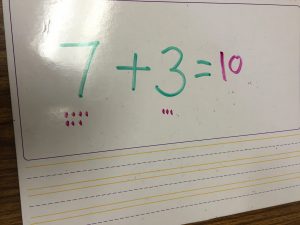
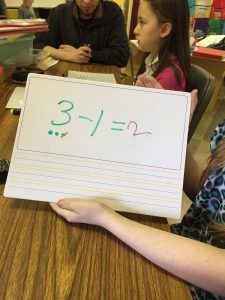
The teacher then provided the following information about the students grade levels, which made it clear that the results from our playtesting session lined up with the information she provided. Following are the students’ current academic functioning levels in mathematics:
- Grade 1 student – 1 student – K/Grade 1
- Grade 2 student – 1 student – K/Grade 1 ( Some students demonstrate splinter skills that necessitate advancement in certain areas – a common strength is geometry over computation with many students)
- Grade 3 – 5 students – one at pre-K, three at K/Grade 1 the last at Grade 2
- Grade 4 – 2 students – one at pre-K the other at Grade 2
- Grade 5 – 2 students – one at 3/4th Grade the second on grade level (Grade 5)
As most of the student in the classroom are at Kindergarten – 2nd grade level of Math, the team decided to focus the game on those levels. As addition is the first concept they learn, we’ll be developing the game focusing on addition first and then based on the remaining time, we’ll focus on subtraction.
Playtesting Section 2:
We also got the digital prototype playtested during our visit. We learned that there were a couple of bugs in the game and that the students liked the dancing animation of robots. We also learned that the content that we were trying to teach in the game was at a much later stage in learning addition, so it was difficult for the students to understand. For example, instead of having 1+2 = 3, we were having the student implement 3 = 1 + 2. This was easy for them, but would have gotten difficult very quickly if we proceeded with this mechanic. For us it is fairly simple, but for students that have just started understanding the math concepts, this is difficult because when we get to the later stages like 30 = 15+15 or 30 = 10+20, it might get too confusing for them if they don’t know that 15 + 15 = 30 or that 10+20 = 30.
Playtesting Section 3:
Lastly, we had a customization activity for the students. We wanted to understand if having a shop in the game where they can customize robots would be a good idea or not. So we cut out some robot parts and asked them to mix and match them. They loved that activity and following are some pictures of the customized robots they made.
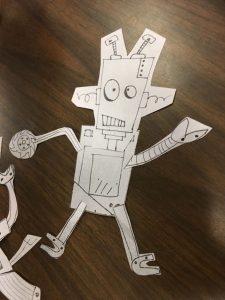
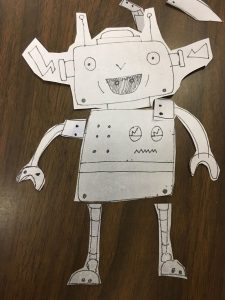
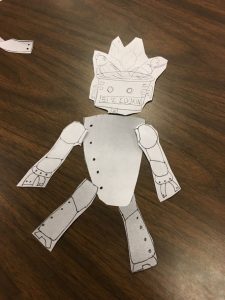
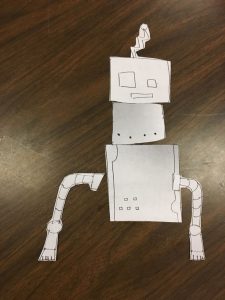
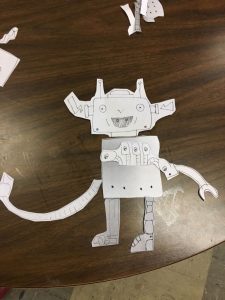
As a conclusion, we are going to finish designing the content of the game first and then work more on the digital prototype. We have a couple of meetings set up with teachers and researchers in this field to get a better idea of how kids are taught math in Kindergarten, 1st and 2nd grade. Based on that information, we’ll finalize the content design and then implement it in the game.